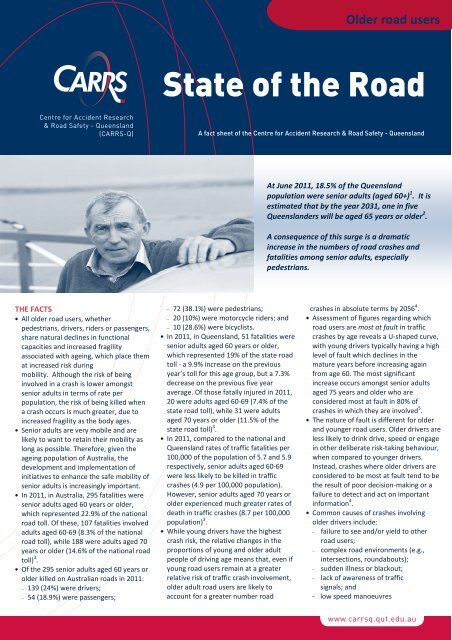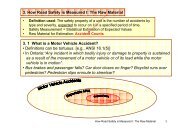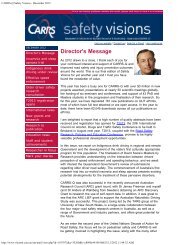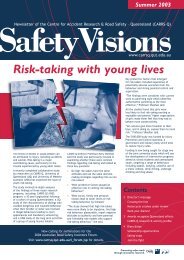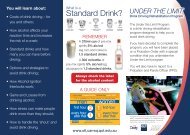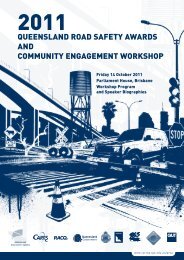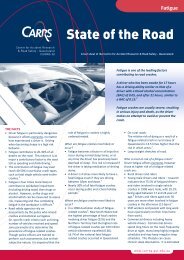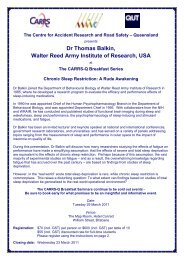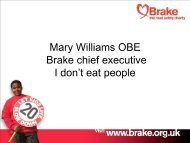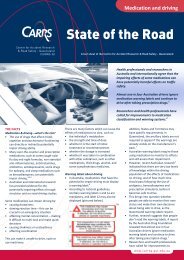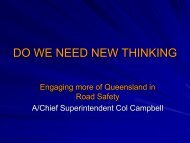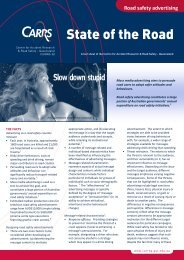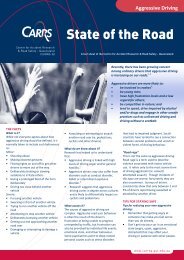Older road users fact sheet - Centre for Accident Research and ...
Older road users fact sheet - Centre for Accident Research and ...
Older road users fact sheet - Centre for Accident Research and ...
You also want an ePaper? Increase the reach of your titles
YUMPU automatically turns print PDFs into web optimized ePapers that Google loves.
<strong>Older</strong> <strong>road</strong> <strong>users</strong>At June 2011, 18.5% of the Queensl<strong>and</strong>population were senior adults (aged 60+) 1 . It isestimated that by the year 2031, one in fiveQueensl<strong>and</strong>ers will be aged 65 years or older 2 .A consequence of this surge is a dramaticincrease in the numbers of <strong>road</strong> crashes <strong>and</strong>fatalities among senior adults, especiallypedestrians.THE FACTS• All older <strong>road</strong> <strong>users</strong>, whetherpedestrians, drivers, riders or passengers,share natural declines in functionalcapacities <strong>and</strong> increased fragilityassociated with ageing, which place themat increased risk duringmobility. Although the risk of beinginvolved in a crash is lower amongstsenior adults in terms of rate perpopulation, the risk of being killed whena crash occurs is much greater, due toincreased fragility as the body ages.• Senior adults are very mobile <strong>and</strong> arelikely to want to retain their mobility aslong as possible. There<strong>for</strong>e, given theageing population of Australia, thedevelopment <strong>and</strong> implementation ofinitiatives to enhance the safe mobility ofsenior adults is increasingly important.• In 2011, in Australia, 295 fatalities weresenior adults aged 60 years or older,which represented 22.9% of the national<strong>road</strong> toll. Of these, 107 fatalities involvedadults aged 60-69 (8.3% of the national<strong>road</strong> toll), while 188 were adults aged 70years or older (14.6% of the national <strong>road</strong>toll) 3 .• Of the 295 senior adults aged 60 years orolder killed on Australian <strong>road</strong>s in 2011:− 139 (24%) were drivers;− 54 (18.9%) were passengers;− 72 (38.1%) were pedestrians;− 20 (10%) were motorcycle riders; <strong>and</strong>− 10 (28.6%) were bicyclists.• In 2011, in Queensl<strong>and</strong>, 51 fatalities weresenior adults aged 60 years or older,which represented 19% of the state <strong>road</strong>toll - a 9.9% increase on the previousyear’s toll <strong>for</strong> this age group, but a 7.3%decrease on the previous five yearaverage. Of those fatally injured in 2011,20 were adults aged 60-69 (7.4% of thestate <strong>road</strong> toll), while 31 were adultsaged 70 years or older (11.5% of thestate <strong>road</strong> toll) 3 .• In 2011, compared to the national <strong>and</strong>Queensl<strong>and</strong> rates of traffic fatalities per100,000 of the population of 5.7 <strong>and</strong> 5.9respectively, senior adults aged 60-69were less likely to be killed in trafficcrashes (4.9 per 100,000 population).However, senior adults aged 70 years orolder experienced much greater rates ofdeath in traffic crashes (8.7 per 100,000population) 3 .• While young drivers have the highestcrash risk, the relative changes in theproportions of young <strong>and</strong> older adultpeople of driving age means that, even ifyoung <strong>road</strong> <strong>users</strong> remain at a greaterrelative risk of traffic crash involvement,older adult <strong>road</strong> <strong>users</strong> are likely toaccount <strong>for</strong> a greater number <strong>road</strong>crashes in absolute terms by 2056 4 .• Assessment of figures regarding which<strong>road</strong> <strong>users</strong> are most at fault in trafficcrashes by age reveals a U-shaped curve,with young drivers typically having a highlevel of fault which declines in themature years be<strong>for</strong>e increasing againfrom age 60. The most significantincrease occurs amongst senior adultsaged 75 years <strong>and</strong> older who areconsidered most at fault in 80% ofcrashes in which they are involved 5 .• The nature of fault is different <strong>for</strong> older<strong>and</strong> younger <strong>road</strong> <strong>users</strong>. <strong>Older</strong> drivers areless likely to drink drive, speed or engagein other deliberate risk-taking behaviour,when compared to younger drivers.Instead, crashes where older drivers areconsidered to be most at fault tend to bethe result of poor decision-making or afailure to detect <strong>and</strong> act on importantin<strong>for</strong>mation 4 .• Common causes of crashes involvingolder drivers include:− failure to see <strong>and</strong>/or yield to other<strong>road</strong> <strong>users</strong>;− complex <strong>road</strong> environments (e.g.,intersections, roundabouts);− sudden illness or blackout;− lack of awareness of trafficsignals; <strong>and</strong>- low speed manoeuvres
The CARRS-Q vision is to decrease the local, national<strong>and</strong> international burden of trauma-related harm.FOR MORE INFORMATIONMarketing & Events OfficerCARRS-QQueensl<strong>and</strong> University of Technology130 Victoria Park RoadKelvin Grove QLD 4059AustraliaPhone +61 (0)7 3138 4568Fax +61 (0)7 3138 7532Email marketing.carrsq@qut.edu.auWebsite www.carrsq.qut.edu.au


